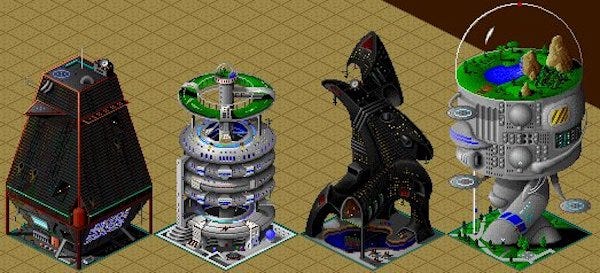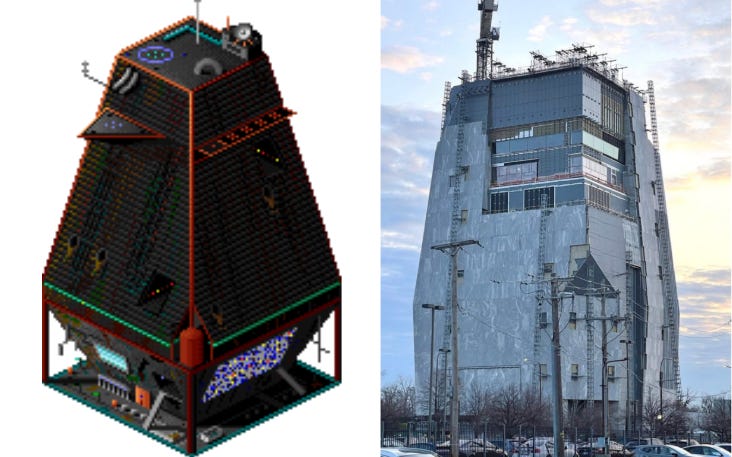The Obama Presidential Library Looks Like The Plymouth Arcology From SimCity 2000
Why are we not talking about this?
The Obama Presidential Library has been promised as “a lively community hub, economic anchor, and beacon of democracy” in the South Side of Chicago, but it presently looks like a brutalist wizard’s tower. While it looks too small to contain 55,000 people, its gray resemblance to the Plymouth industrial arcology of the SimCity 2000 game is too uncanny for me not to see it.
It’s missing the giant Blade Runner 2049 billboard display in the breezeway, and the sides have slightly less slope, but ‘the Obamalisk’ is the same basic shape, and there is a stained glass window on one side. The resemblance is uncanny. Barack Obama loves to talk about architecture as his first love, says he loved sharing his sketches with the designers so much that it likely annoyed them: “I’m sure there were times when I got on their nerves a little bit.” It is hard to believe this is a pure coincidence. Are we even going to talk about this?
An arcology is an integrated vertical city — a skyscraper that contains everything its residents need, from groceries to schools to social services. Players of SimCity 2000, easily the best installment of the entire classic game series, get access to these buildings in the 21st century. They alter the complexion of the late game by allowing greater population density. For the benefit of normies and non-players, here is the in-game description of the Plymouth Arco.
The Plymouth Arco is “Solid as a Rock”, or so claims Plymouth Arcologies, Inc. It is known that they have stood through several earthquakes, notably in the NeoRepublic of Mexico and the Taiwan CoProsperity Region. Plymouth Arcologies are designed primarily to support heavy industries, as witness Greenland Motors, maker of the Narwhal 3000. This might not be such a good choice if you are overly concerned about pollution.
Tod Williams Billie Tsien Architects, a husband-wife team based in New York City, designed the new library in conjunction with Chicago-area firms. Obama awarded them the National Medal of Arts in 2013 along with fellow honorees Linda Ronstadt, Jeffrey Katzenberg, and about eighteen other very talented people who are completely unfamiliar to me.
“The structure is the centerpiece of what will be by far the most expensive presidential center ever constructed and, like the president whose vision shaped it, it is setting off intense and often conflicting reactions”, The New York Times reports. Opening in the spring of 2026, if all goes according to plan, the $850 million facility will not be a normal research library. The Obama Foundation, rather than the National Archives and Records Administration, will run the show on a four-building campus that is meant to anchor the neighborhood.
“A financial impact study the foundation commissioned from Deloitte estimated that the Obama Presidential Center would attract 625,000 to 760,000 visitors annually”, the NYT reports. They will be able to read Obama’s speech, given at the 50th anniversary of the Selma-to-Montgomery march, installed in the facade of the upper stories of the building. They can visit the fruit and vegetable garden — a recall of Michelle Obama’s White House garden — and examine artwork by more than two dozen artists chosen by the Obamas. Visitors can sled down the artificial hills in winter, which does sound like a fun afternoon for a family with small kids.
Put simply, the library is supposed to create jobs like the Plymouth Arco, but with all the attention to water management and environmental impact of the Forest Arco. It’s the second from the left in this image showing the four different arcologies in the SimCity 2000 game. The Forest Arcology is “named for its attractive forest setting on the top level” and it offers a carbon-neutral, net zero lifestyle.

Our decade-long surge of campus activism has been a legacy of the second Obama term, when he supported a series of campaigns at colleges and universities starting with the ‘It’s On Us’ campaign in 2014. It sought to end sexual assault on campus and ultimately produced a quasi-judicial process for adjudicating complaints that canceled the constitutional rights of the accused. Just like the legacy of the Obama administration, the only form of pollution that the Forest Arco willingly creates is anxiety in young people.
Throughout the structure, citizens utilize recycling, operate ecologically sound industries, and maintain a rich verbal heritage that replaces television and radio. Unfortunately, the youth of Forest Arcos are bored silly and roam out into your city where they stare mindlessly at soap operas and sports programs displayed in the electronics department at local malls.
It is not really a stretch to suggest that Barack Obama’s architectural sensibility may derive from a decades-old video game, which itself reflected an earlier iteration of the environmentally-conscious future that Obama had in mind before his presidency, that he tried to enact as green energy policy during it.
Now the construction of the library is drawing criticism for gentrification, one of several urban policy issues that was never addressed in any iteration of the SimCity games. This new building is supposed to monumentalize the Obama presidency in a particularly controversial and divisive way — a fitting remembrance of the Obama presidency itself, which resolutely deserves its own mausoleum clad in New Hamphsire granite.
We are now one-quarter of the way through the 21st century and arcologies have not caught on. Skyscraper communities remain the stuff of science fiction. The legacy of the Obama presidency seems to shrink and fade all the time, too. Like the arcology, it seemed futuristic until it was no longer the future. Now that it is in the past, it becomes harder to like all the time.
Judge Dredd Arrests Poverty, Puts It In An Iso-Cube For Mega City One Crimes
“The poorer the population the more violent crimes they commit and we just let a lot of really poor people in,” Judge Hershey says on page three of A Better World. A few pages later, Judge Maitland discovers that “we can wipe out crime” if Mega City One just spends all the money on education instead of judges, according to her “models” of criminality. Maitland’s reasoning leaps from environmental intervention — cleaning up slums and improving urban architecture — into a “social engineering” panacea for all forms of crime, using anecdotal examples of ‘reform’ in much the same way anti-police ‘social justice’ advocates do in the real world.



